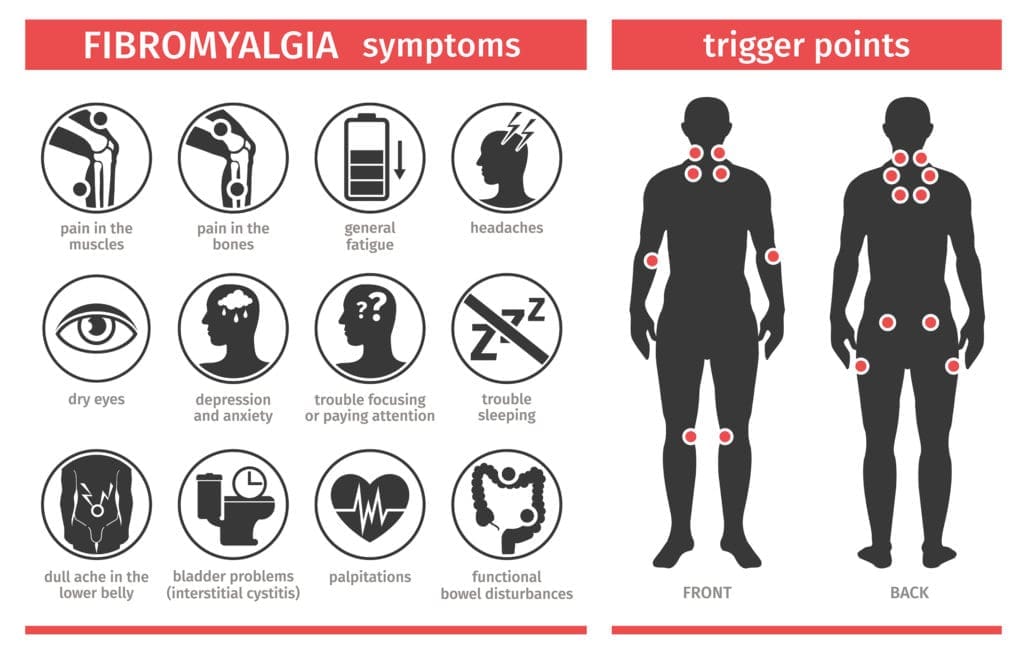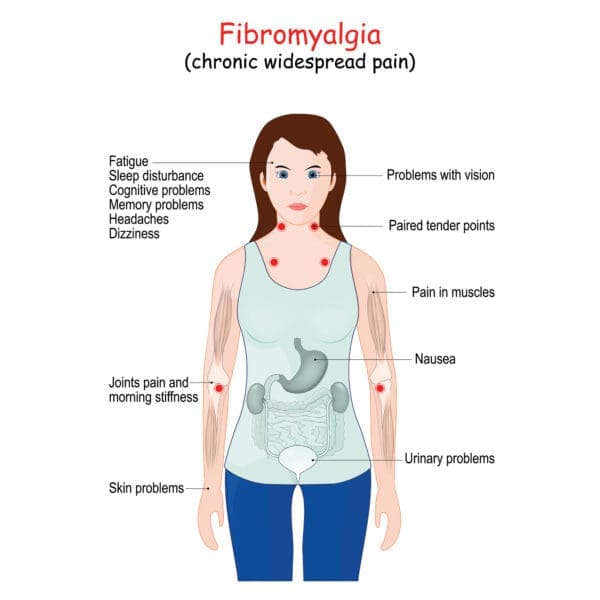What is Fibromyalgia? – Overview
Often misdiagnosed and misunderstood, fibromyalgia is a common condition. People with this condition experience widespread muscle and joint pain as well as intense fatigue. But just what is fibromyalgia?
Anyone can develop this chronic condition. It causes many common symptoms. While there isn’t a cure, there are treatment options, lifestyle changes and coping techniques that can help you manage pain. We’ve got the answers you need to help relieve your pain below.
Fibromyalgia 101

Fibromyalgia is a chronic condition that causes widespread pain and tenderness as well as muscle and joint pain. It also causes fatigue, among various other symptoms.
These symptoms can be severe. Fibromyalgia affects the way you function from day to day. Doctors aren’t sure what causes this condition. However, some think that it might be caused by how the brain and spinal cord process pain signals from nerves.
It’s estimated that 3-6% percent of people across the globe live with it.
Fibromyalgia doesn’t fall under the category of rheumatic diseases, or diseases that cause inflammation or damage to your joints, tissue or muscles. Its common symptoms are close to that of arthritis though. This means you might be referred to see a rheumatologist to help you develop an effective treatment plan.
What causes Fibromyalgia?
Medical experts do not fully understand fibromyalgia or its exact causes yet. They do know that people with it experience amplified pain due to an abnormality in how their central nervous system processes pain. They also believe that genetic factors may leave an individual more likely to develop fibromyalgia.
Some people experience a slow, gradual onset of symptoms. The majority of people with fibromyalgia seem to develop the condition after it is triggered by an illness or injury. It’s possible that such a trauma aggravates an existing physiological problem that the individual wasn’t aware of previously.
Risk factors of fibromyalgia include:
- Your age: While it can affect people of all ages, including children, you are more likely to develop fibromyalgia as you get older
- Having lupus or rheumatoid arthritis
- Your sex: Women are twice as likely to have fibromyalgia as men
- Experiencing traumatic events such as car accidents or post-traumatic stress disorder
- Enduring repetitive injuries that put stress on one of your joints
- Experiencing illness (such as viral infections)
- Having a family history of the condition
- Being obese
More research is needed to fully understand its causes and potential improved management methods.
What are the symptoms of Fibromyalgia?
 Everyone is different and may experience a variety of symptoms. However, fibromyalgia has several common symptoms including:
Everyone is different and may experience a variety of symptoms. However, fibromyalgia has several common symptoms including:
- Widespread muscle and joint pain
- Fatigue
- Sleep problems
- Low pain threshold
- Memory and mood issues
- Chronic headaches
- Jaw pain
- Trouble concentrating or remembering (fibro fog)
While not as common, there are other possible symptoms of fibromyalgia, which may include:
- Belly pain, bloating or indigestion
- Heart palpitations
- Muscle weakness
- Dizziness and balance problems
- Tingling or numbness sensations in your hands and feet
- Sensitivity to cold, heat, light, sound or strong smells
Having fibromyalgia has been compared to having the flu. The symptoms may fluctuate throughout the day. They may also flare up when aggravated. Factors such as weather changes, high stress levels, cold environments and overexertion can all cause flareups. Even without these aggravating factors, fibromyalgia symptoms can be unpredictable, making it difficult for people living with fibromyalgia to make plans.
Many symptoms of fibromyalgia can be symptoms of other conditions. In fact, fibromyalgia symptoms may mimic Raynaud’s Syndrome, irritable bowel syndrome (IBS), restless leg syndrome (RLS) and more. This makes fibromyalgia particularly challenging to diagnose. If you have any of these symptoms, it’s best to see your doctor to discuss them.
How is Fibromyalgia diagnosed?
When you visit your doctor, she will start by taking a detailed medical history. There is no particular blood test or x-ray that will indicate she can use to diagnose fibromyalgia. Instead, diagnosing it involves your doctor ruling out other potential causes of your pain. She will also consider all of your symptoms as a whole.
To rule out other potential causes, she may order blood work, lab work and other tests. It can take some time before she will arrive at a fibromyalgia diagnosis. Doctors who are unfamiliar with fibromyalgia may not arrive at a conclusive diagnosis at all.

The American College of Rheumatology established criteria to classify the presence of fibromyalgia. This criteria includes that:
- a patient have a history of widespread pain in all four quadrants of the body
- the pain has lasted for at least 3 months
- a patient should experience pain in at least 11 of 18 designated tender points throughout the body when pressure is applied.
Is there a cure for Fibromyalgia?
Unfortunately, there is no cure for fibromyalgia. It is often best managed through lifestyle adaptation.
What is the best treatment for Fibromyalgia?
Once your doctor diagnoses you, she will work with you to develop a treatment plan. Your plan might include medications, lifestyle changes and natural pain management techniques.
There are a few medications specifically designed to help people with fibromyalgia. These include:
- duloxetine (common brand name Cymbalta and Irenka)
- milnaciprin (common brand name Savella)
- pregabalin (common brand name Lyrica)
Your doctor will likely want to have regular follow-up visits with you. This is to ensure your medications are working properly and to check on how you’re feeling.
Your personalized treatment for fibromyalgia includes certain lifestyle changes as well and can be helpful to reduce pain. These changes may include eating a balanced, healthy diet, drinking plenty of water, getting regular exercise and resting more often.
Balancing your activity level with your rest is important. It’s perfectly fine to take time to rest when you need it.
Some natural pain management techniques may also be part of your treatment plan. These may include yoga, Tai Chi, talking with a counselor and gentle massage. Look for activities that help you cope, give you comfort and make you happy. Always talk with your doctor before changing how you’re treating fibromyalgia.

Living with fibromyalgia isn’t easy. But learning about your condition and what steps you can take may help you live a more active lifestyle. Mental health support can be particularly valuable as you follow your treatment plan. This can include support from your family and friends or through a therapist or other professional health care provider.
Learn more about fibromyalgia warning signs in this video:
What should I do if I am newly diagnosed?
Being diagnosed may mean that you need to make some changes in your life. However, it also identifies the cause of the widespread pain and fatigue that you’ve been experiencing.
To navigate a new fibromyalgia diagnosis, be sure that you have a doctor who is supportive and familiar with the condition. She can help you to create a plan to manage your condition in ways that improve your quality of life.
NEW UPDATE:
First Patient Dosed in Phase 2a Clinical Trial for the Treatment of Fibromyalgia at The University of Michigan
Tryp Therapeutics, a clinical-stage biotechnology company, has initiated a Phase 2a clinical trial in collaboration with the University of Michigan. The trial focuses on evaluating the use of Tryp’s TRP-8802, an intravenous-infused form of psilocin, in patients suffering from fibromyalgia—a condition with significant unmet medical needs. The announcement marks the dosing of the first patient in this innovative study, highlighting the company’s commitment to exploring novel treatments for challenging medical conditions. Full article source
How do you alleviate your fibromyalgia pain?
Tell us about your experience in the comments below.


There is no cure for fibromyalgia, it can worsen over time, but I’ve found once you tailor your lifestyle, resist the temptation to take medications, that only treat symptoms, and further overload the nervous system, you can make improvements.
Reduce stress, eat a fresh diet, take vitamin D, amino acids. Light exercise, sleep alone, take hormones, have regular massages.
I retired from work and have managed to improve my symptoms.
Having a positive outlook helps, research the condition, remove as much stress as you can.
Hy can u help me plz I had same problem. Its very pain full. Plzz plzz help me.
Hi Naheed.
Thanks for stopping by Pain Resource. I’m sorry to hear that this condition is causing you a lot of pain. The first step is to speak with your doctor. He or she will be able to map out the best treatment plan for your particular condition, since every person is different. If you are working with a doctor and aren’t getting the relief you need, schedule another appointment and tell your doctor what’s going on. Often we have to work to get the treatment that we need to feel better.
On our site we seek to offer helpful information that supplements your plan laid out together by you and your primary care doctor. We also have a community where people share successes and support one another. We’d love to have you as a part of our community. Please visit forum.painresource.com to join.
Thanks,
Your Friends at Pain Resource